
Saudi Arabian oil exports to the U.S. more than doubled from February to March as oil prices crashed and American shale producers reeled over demand destruction from the coronavirus pandemic, data from analytics firm TankerTrackers.com shows, CNBC reported.
Saudi crude shipments to American ports went from an average of 366,000 barrels per day (bpd) in February to 829,540 bpd in March — a multiple of 2.27. For the last month, that means Saudi Arabia shipped around 25 million barrels of crude to the U.S., a level not seen since December 2018.
And data from TankerTrackers.com shows that figure is on track to be surpassed in April. Satellite tracking of VLCCs, the vessels that transport crude, tracked a whopping 1.46 million barrels per day of Saudi oil shipped to the U.S. in the first two weeks of April alone — four times February’s daily volume and the highest since 2014. The majority of tankers went to the Gulf Coast, with a smaller proportion going to Californian ports.
According to Saudi state oil producer Aramco’s website, the company was loading 15 tankers for its international customers on April 1 — the day a previous OPEC production cut agreement with its oil-producing allies, OPEC+, expired — supplying the tankers with a record 18.8 million barrels in a single day.
The boost in exports comes against the backdrop of one of the most dramatic periods in oil market history: Record oil output from the world’s largest oil producers juxtaposed with eviscerated demand due to worldwide coronavirus lockdowns as economic activity and global commercial transport came to a screeching halt.
“Towards the end of March I saw massive boosts in gas flaring in the fields in the Eastern Province, so they went pedal to the metal and pumped out as much as possible,” Samir Madani, founder of TankerTrackers.com, told CNBC over the phone Thursday. “It lit up like a Christmas tree, the whole Eastern Province, all the flares just came back online.”
Saudi Arabia’s Eastern Province is home to the world’s largest oil fields and processing facility, and the majority of the kingdom’s production.
According to CNBC, ahead of the April 1 expiration of the previous OPEC+ cutting deal, Saudi Arabia slashed its official selling prices (OSP) to its customers. At the same time, Saudi barrels headed to its top buyer, China, likely had to be re-routed due to China’s extensive lockdown meant to combat the spread of the coronavirus in the country.
“I am guessing that was in the immediate aftermath of the failed OPEC+ meeting at the beginning of March,” Tamas Varga, an oil analyst at PVM Oil Associates, told CNBC. “That’s when Saudis promised to increase production and exports significantly and cut OSP by several dollars.”
In early March, negotiations between OPEC and its allies failed when Russia rejected Saudi Arabia’s terms to cut production in order to boost prices, leading both states to reverse course and set off a price war, with the Saudis increasing production and slashing selling prices for its customers.
The move was so destructive to oil markets — particularly the U.S. shale industry — that U.S. President Donald Trump called on the producers to rein in their output, though he did not do the same for U.S. shale companies, which are now seeing bankruptcies, capex cuts and production shut-ins due to market pressure, CNBC adds.
At the same time, China’s demand for oil dropped significantly, as it kept its major economic hubs under lockdown and factories across the country of 1.4 billion remained closed. From February to March, Saudi oil shipments to China fell by nearly 800,000 bpd, picking up again to about 1.3 million bpd in the first half of April.




Be the first to comment